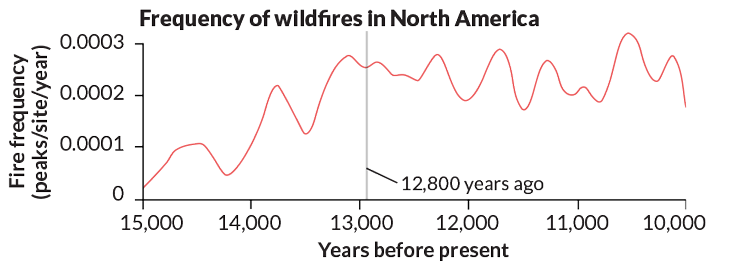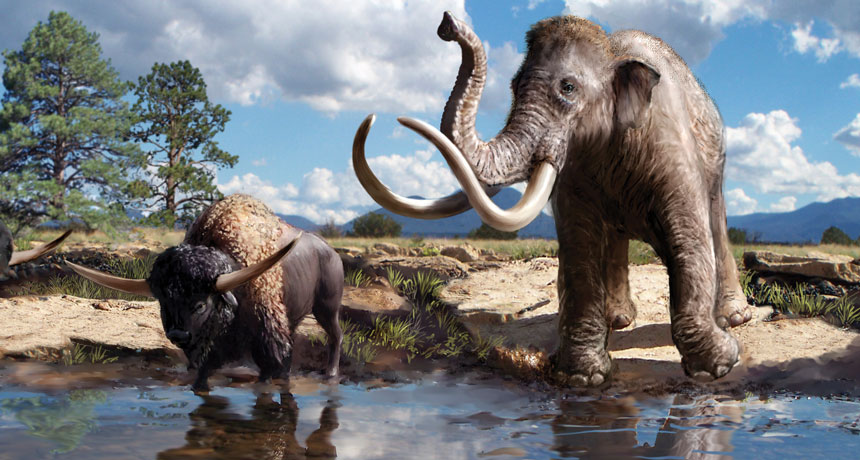
WHERE’D THEY GO? About 13,000 years ago, during the Pleistocene Epoch, bison, mammoths (illustrated) and other large mammals roamed North America. Researchers continue to argue over what caused their extinction.
Victor O. Leshyk
Around 13,000 years ago, Earth was emerging from its last great ice age. The vast frozen sheets that had covered much of North America, Europe and Asia for thousands of years were retreating. Giant mammals — steppe bison, woolly mammoths and saber-toothed cats — grazed or hunted across tundra and grasslands. A Paleo-Indian group of hunter-gatherers who eventually gave rise to the Clovis people had crossed a land bridge from Asia hundreds of years earlier and were now spread across North America, hunting mammoth with distinctive spears.
Then, at about 12,800 years ago, something strange happened. Earth was abruptly plunged back into a deep chill. Temperatures in parts of the Northern Hemisphere plunged to as much as 8 degrees Celsius colder than today. The cold snap lasted only about 1,200 years — a mere blip, in geologic time. Then, just as abruptly, Earth began to warm again. But many of the giant mammals were dying out. And the Clovis people had apparently vanished.
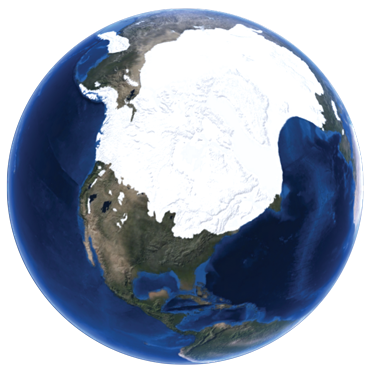
Geologists call this blip of frigid conditions the Younger Dryas, and its cause is a mystery. Most researchers suspect that a large pulse of freshwater from a melting ice sheet and glacial lakes flooded into the ocean, briefly interfering with Earth’s heat-transporting ocean currents. However, geologists have not yet found firm evidence of how and where this happened, such as traces of the path that this ancient flood traveled to reach the sea (SN: 12/29/12, p. 11).
But for more than a decade, one group of researchers has stirred up controversy by suggesting a cosmic cause for the sudden deep freeze. About 12,800 years ago, these researchers say, a comet — or perhaps its remnants — hit or exploded over the Laurentide Ice Sheet that once covered much of North America (SN: 6/2/07, p. 339 ).
Pieces of the comet most likely exploded in Earth’s atmosphere, the researchers suggest, triggering wildfires across North America. Those fires would have produced enough soot and other compounds to block out the sun and cool the planet. Most scientists think that a similar aboveground explosion, known as an airburst, happened on a far smaller scale in 1908 over Siberia’s Tunguska region. That event produced as much energy as 1,000 Hiroshima bombs (SN Online: 7/28/09). A similar but even larger cataclysm at the onset of the Younger Dryas, according to the hypothesis’s proponents, would neatly solve several prehistoric puzzles, including what caused the extinctions of large animals and what happened to the Clovis people.
We summarize the week's scientific breakthroughs every Thursday.
For more than a decade, scientific journals have been the battleground for skirmishes over this impact hypothesis. The idea has drawn opponents from a spectrum of scientific fields, including paleoclimatology, physics and archaeology. The critics contend that there is little to no reproducible or incontrovertible evidence for many of the key arguments of the hypothesis.
“Over and over and over, there are these things that are claimed to be proxies for an impact,” says Vance Holliday, an archaeologist and geologist at the University of Arizona in Tucson. “And they’re all debatable, every single one.”
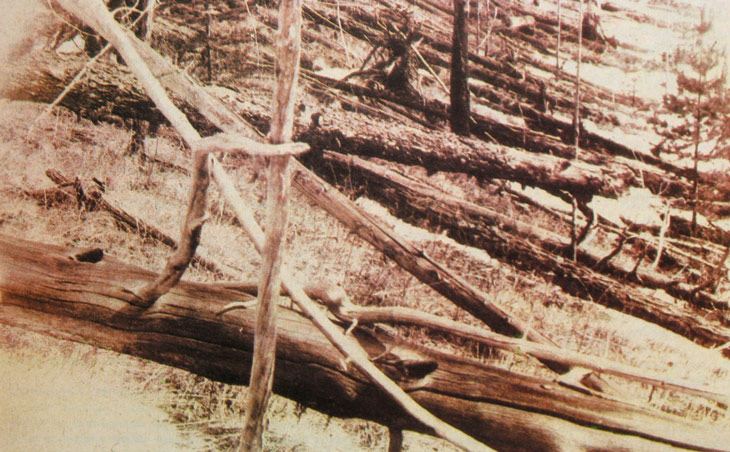
Allen West, a retired geophysicist who owned GeoScience Consulting in Dewey, Ariz., has long been a lead proponent of the impact hypothesis. West acknowledges that the hypothesis has been battered on all sides. “We have different battles with different disciplines,” he says. He compares these battles to the fights that raged in the 1980s over whether an asteroid struck Earth 66 million years ago, killing off all dinosaurs except birds — an idea that he notes is now widely accepted.
“There were just vicious, nasty attacks for nearly a decade on that,” West says. “People said it just couldn’t have happened, and then they found the crater. That’s probably what it would take with us, too.”
Indeed, no craters have been found dating to the Younger Dryas, and the landscape of North America — the likely ground zero for such an impact, proponents say — has been pretty thoroughly checked out. In the absence of direct evidence of an impact, West and colleagues have turned to indirect evidence, releasing a steady stream of papers outlining numerous possible signs of an impact, all dating to about 12,800 years ago.
The latest salvo came in March, when West and more than two dozen researchers published a pair of papers in the Journal of Geology. The papers include data from ice cores as well as sediment cores from land and sea. The cores contain signatures of giant wildfires that support the idea of a widespread burning event about 12,800 years ago, West says.
The papers promptly elicited exasperation from some opponents, including Holliday. “We have 10 years of this we have to deal with. They keep building on their past record, ignoring the critiques,” he says. “It just drives me crazy.”
Birth of a hypothesis
The first formal description of the Younger Dryas impact hypothesis came in 2007, when four researchers sat in front of a gaggle of reporters at the American Geophysical Union’s spring meeting in Acapulco, Mexico. The researchers, including West, had taken a close look at about two dozen sites across North America showing a “boundary layer” of sediments dating to the onset of the Younger Dryas. Half a dozen of the sites also have thin layers of organic-rich sediments called “black mats” immediately overlying the boundary layer. Several of those sites show signs of occupation by the Clovis people.
The mats apparently mark the line between occupation and absence at the Clovis sites: For example, a black mat at a site called Murray Springs, in Arizona, sits above a trove of Clovis artifacts, a fire pit and an almost fully articulated skeleton of an adult mammoth. But above the mat, there are no such artifacts; at Murray Springs and elsewhere, the fluted stone spearpoints made by the Clovis culture disappear from the archaeological record, leading to speculation that the people mysteriously and abruptly vanished.
Those Younger Dryas boundary layers, West and colleagues reported in 2007, contain a variety of intriguing items, including tiny round magnetized grains called microspherules, other magnetized grains of sediment, little spherules of carbon, hollow round carbon molecules called fullerenes and nanodiamonds. Chemical analyses also revealed spikes in iridium and nickel concentrations and in charcoal and soot.
Taken alone, these items may or may not be signs of an extraterrestrial impact: Microspherules, for instance, form when a material heats up and then rapidly cools. They can form during a volcanic eruption, from industrial pollution or as a result of an extraterrestrial impact.
But when taken together, such a suite of markers could point only to an extraterrestrial impact, the researchers concluded: Something struck Earth and exploded in its atmosphere at the onset of the Younger Dryas, about 12,800 years ago. The soot and charcoal suggested that the impact triggered widespread burning that blocked out the sun and brought about a thousand years of near-glacial temperatures in the Northern Hemisphere.
Because no impact crater dating to this time has been found, the researchers suggested that the impactor was probably already fragmented when it entered Earth’s atmosphere. Smaller fragments would have done plenty of damage as they exploded in the atmosphere over the retreating Laurentide Ice Sheet, but they wouldn’t have left much of a smoking hole in the ground.
The news made a splash — and scientists were intrigued (SN: 6/2/07, p. 339). The prospect of layers rich in impact markers found scattered across a continent was definitely worth investigating further. Mark Boslough, a physicist at the University of New Mexico in Albuquerque, says that initially, he took the data at face value. “I thought, ‘they’re on to something interesting.’ ”
Frustrations mount
Then scientists, Boslough included, began to do their own independent analyses. And questions arose. Some researchers claimed that they couldn’t find strong evidence of some of the purported impact markers, such as the microspherules and nanodiamonds. Others questioned the precision of the dating at many of the Younger Dryas boundary layer sites, which would undermine the idea that one event affected them all simultaneously.
Boslough says he took issue with the physics of the proposed impact mechanisms, which have ranged from a single object striking the ice sheet to multiple fragments exploding in the atmosphere. But none of the scenarios make sense, Boslough says. Either the pieces of a fragmented comet would have been too small to generate much energy or they would have been too large not to leave craters, he wrote in 2012.
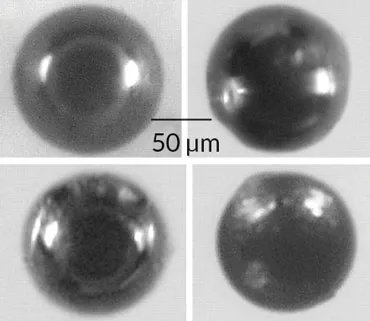
Holliday, meanwhile, says that when it comes to the apparent disappearance of the Clovis culture, the Younger Dryas impact hypothesis is a solution to an archaeological problem that doesn’t exist. Hunter-gatherers like the Paleo-Indian people who made Clovis points didn’t stay at one site for long; it’s no surprise that they would have moved on, Holliday says.
More important, he adds, “there is no mysterious ‘gap’ in the archaeological record following the time that Clovis artifacts were made.” Immediately following the Clovis period, a different style of projectile points, called Folsom points, appeared. Paleo-Indian peoples probably just changed their spear technology due to a shift from hunting mammoth and mastodon to bison, Holliday says.
As for those large Ice Age animals such as mammoths, he adds, they were in decline, but their disappearance wasn’t that sudden. “All these animals running around and then, boom, at 12,800 years ago they just go away? That’s just not the case,” Holliday says. “These extinctions were global and happened at different times around the world.”
The March papers focus mainly on the wildfires, a long-standing aspect of the original hypothesis. Greenland ice cores show peaks in ammonium dating to the onset of the Younger Dryas, which the researchers say, suggests large-scale biomass burning. These data were previously presented in 2010 by astrophysicist Adrian Melott of the University of Kansas in Lawrence and colleagues. They suggested that the ammonium ions in those ice cores could be best explained by an extraterrestrial impact. A similar spike dating to 1908 — the year of the airburst over Siberia — had also been found in those same cores. The papers also describe finding peaks in charcoal that date to the start of the cold snap.
“The big thing here is a careful comparison of [many possible impact markers], normalized to the same dating method,” says Melott, one of the authors on the new impact papers. Those markers, including previously described evidence of microspherules, iridium and platinum dust, are consistent with having been caused by the same event, he says.
However, Jennifer Marlon, a paleoecologist and paleoclimatologist at Yale University and an expert on biomass burning, has taken her own look at sediments in North America dated to between 15,000 and 10,000 years ago. She sees no evidence for continent-wide fires dating specifically to the onset of the Younger Dryas.
“I’ve studied charcoal records for many years now,” Marlon says. In 2009, she and colleagues reported data on charcoal and pollen in lake sediments across North America. Importantly, the sediment records in her study encompassed not only the years of the Younger Dryas cold episode, but also a few thousand years before and after.
Her team found multiple small peaks of wildfires, but none of them were near the beginning of the Younger Dryas. “Forests burn in North America all the time,” she says. “You can’t find a cubic centimeter of sediment in any lake on this continent that doesn’t have charcoal in it.”
Such fires could be triggered by rapid climate change, when ecosystems are quickly reorganizing and more dead fuel might be available. “That can cause major vegetation changes and fires,” Marlon says. “We don’t need to invoke a comet.”
The problem with the data in the recent papers, Marlon says, is that the researchers look only at a narrow time period, making it difficult to evaluate how large or unusual the signals really were. From her data, there appeared to have been more burning toward the end of the Younger Dryas, when the planet began to warm abruptly again.
“That speaks to my fundamental problem with the biomass burning part of the papers,” Marlon says. “I don’t understand why they’re zooming in. It’s what makes me skeptical.”
Holliday echoes that criticism. “Most of the time they sample only around this time interval,” he says. What would be more convincing, he says, are data from cores that span 15,000 to 20,000 years, sampled every five centimeters or so. “If this is a unique event, then we shouldn’t see anything like it in the last 15,000 years.”
West says that other peaks are irrelevant, because the impact hypothesis doesn’t imply that there was only one wildfire, just that one occurred around 12,800 years ago. He adds that the new papers suggest that Marlon and her colleagues didn’t correctly calibrate the radiocarbon dates for their samples. When done correctly, he says, one spike in fires that Marlon estimated at around 13,200 years ago actually occurred several hundred years later — right around 12,800 years ago.
Radiocarbon dating for such old events is challenging regardless of calibration, Marlon says. That’s why she analyzed and compared her sites in several different ways, yet still found no unusual peak at 12,800 years. In fact, she says, many of the sites show no signs of burning at that time.
As for whether the impact hypothesis proponents have ignored scientific criticisms, West rejects this. “We have directly rebutted those criticisms multiple times,” he says. An upcoming paper he and others are preparing will describe in detail those rebuttals, such as errors he says previous critics made in properly reproducing the analyses West and his colleagues used to identify a key impact marker, the magnetic spherules.
Yet critics of the Younger Dryas impact hypothesis say that too many questions remain unanswered. Holliday says he and others are preparing a response to the Journal of Geology papers, outlining numerous points of contention.
“Confronting and dealing with critical reviews and contradictory data is a significant problem in this debate,” Holliday says. None of the rebuttals have dealt with various criticisms, he adds, such as the proper dating of rock layers and soils, and the contradictory data over animal extinctions and Paleo-Indian archaeology.
“We all love a good debate,” Marlon says, “but I know there’s a lot of frustration in the community” that this hypothesis persists. Like many opponents of the impact hypothesis, she says that the data presented in the new papers have done nothing to change her mind about the comet strike. “It didn’t happen.”
All the same, Marlon understands the allure. “I have had pet theories, too. We are pattern-seekers. We tend to see things that look like a signal and so many times they’re not. A comet is simpler and more visually compelling — more appealing, in a way — than trying to sort out what Earthbound trigger might have caused such an abrupt climate change.
“I wish the evidence were stronger for [an impact],” she says. “It’s not as much fun when it turns out to be a more complicated, nuanced story.”
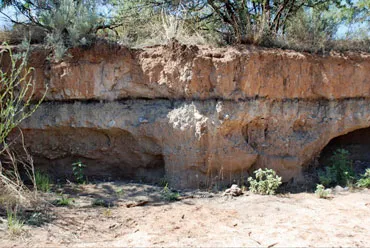
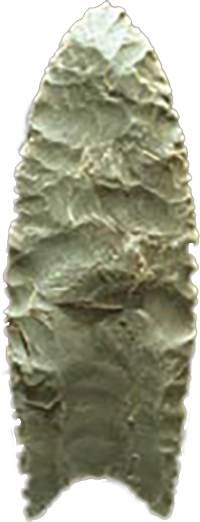 At Arizona’s Murray Springs, an organic clay layer, or black mat, dating to around 12,800 years ago, sits on top of deposits containing Clovis artifacts (spearpoint, right) and skeletons of large game. Some researchers say the layer holds markers of an extraterrestrial impact.
At Arizona’s Murray Springs, an organic clay layer, or black mat, dating to around 12,800 years ago, sits on top of deposits containing Clovis artifacts (spearpoint, right) and skeletons of large game. Some researchers say the layer holds markers of an extraterrestrial impact.